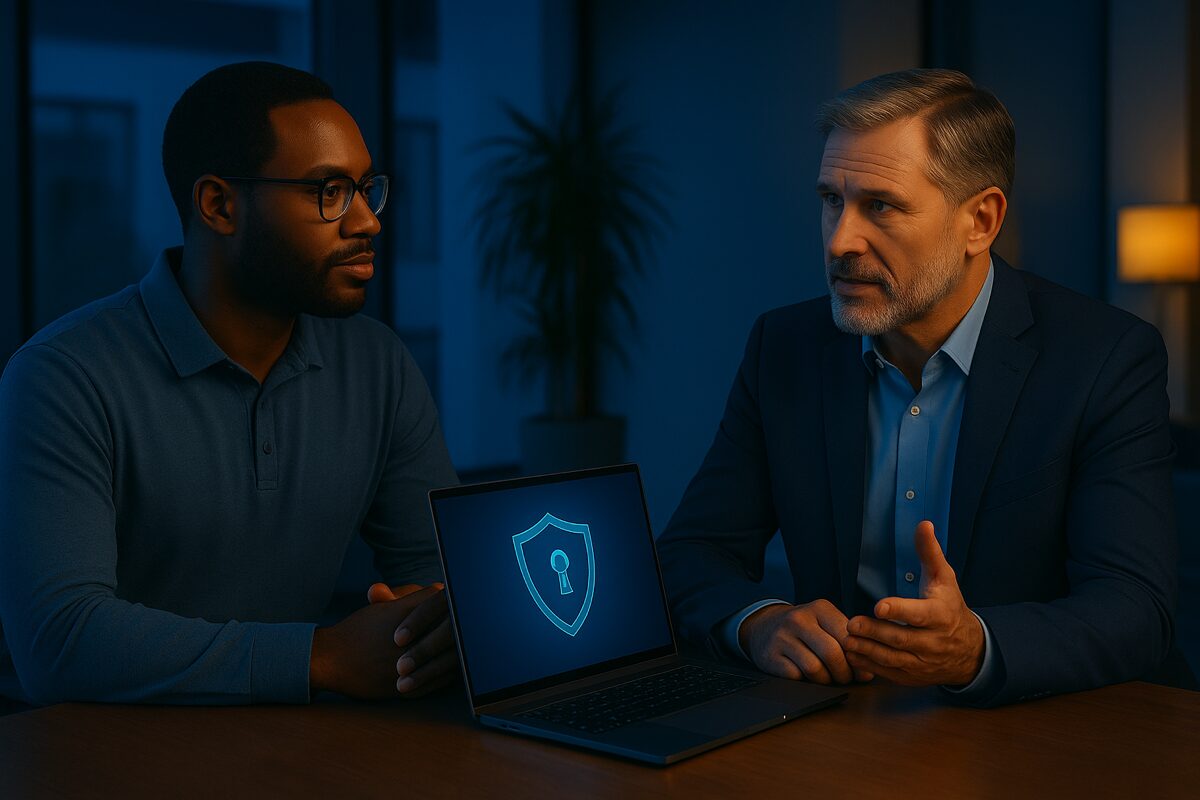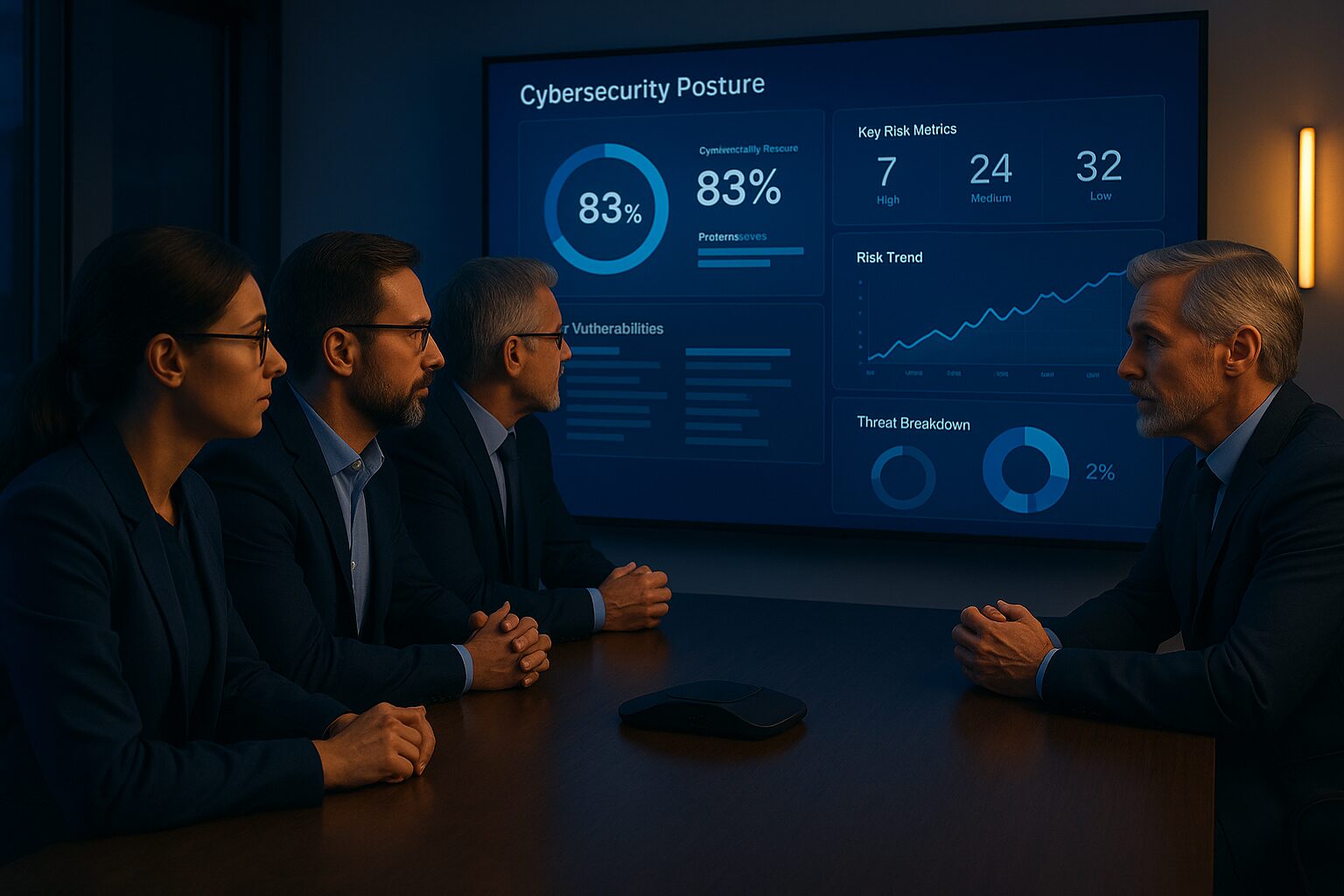This post recaps key insights from our February webinar, where Adam Pendleton, Chief Information Security Officer at Meriplex, and Jason Barnhizer, Director of Threat Operations at Blackpoint Cyber, broke down the new cybersecurity reality every business needs to prepare for.
There’s no more buffer time. No more early warning signs. No more leisurely windows between “something feels off” and “we’ve got a problem.”
Cyberattacks in 2025 are fast. They are automated. And they are overwhelmingly identity-based. Nearly half of all successful breaches in 2024 involved data exfiltration within just 24 hours, according to IBM’s Cost of a Data Breach Report. That means by the time most teams realize something’s wrong, the threat actor is already gone—with sensitive data in hand.
The truth is, many organizations are still relying on frameworks built for a slower world. A world where “detect and respond” was enough. A world where you could wait for an alert, investigate, then act.
That world no longer exists.
This post is your reality check—and your roadmap. We’re breaking down the seven essential security upgrades every business should prioritize in 2025 if they want to reduce risk, protect data, and build a foundation that holds up to what’s coming next.
Because staying secure today isn’t about reacting. It’s about designing smarter systems, closing known gaps, and building a culture that’s ready to move as fast as the threats do.
1. Real-Time Threat Detection and Response
One of the biggest shifts in 2024 wasn’t just the number of cyberattacks—it was how quickly they happened.
Dwell time, the window between an initial breach and full execution, has dropped sharply. In nearly half of successful attacks last year, data was exfiltrated in under 24 hours. That’s according to IBM’s 2024 Cost of a Data Breach Report. And in many cases, attackers weren’t waiting around—they were automating their way in, extracting sensitive data, and disappearing before anyone had time to blink.
This is where traditional alert-based detection falls short. If your team finds out about an incident via a ticket in their inbox or a Slack ping at 9 a.m., it’s already too late.
In 2025, businesses must treat real-time threat detection as a core competency, not a nice-to-have. That means investing in security operations that are built for speed, coordination, and decisiveness.
The solution starts with tools like Managed Detection and Response (MDR), which combine continuous threat hunting, automated response capabilities, and human expertise to detect and isolate attacks in real time. But it doesn’t stop there.
It’s about building a security culture that knows how to move fast when it matters most:
- Automated containment: Systems that instantly quarantine compromised users, devices, or network segments as soon as a threat is flagged.
- Runbook-driven response: Predefined playbooks for incidents like ransomware, phishing, or insider threats—so your team isn’t figuring it out on the fly.
- Cross-functional readiness: Incident response isn’t just for IT anymore. Involve legal, PR, HR, and operations. Everyone needs to know their role when things go sideways.
The companies that will thrive in 2025 won’t just detect threats faster. They’ll make decisions faster. Communicate faster. Contain faster. Because resilience today isn’t about having the best tools. It’s about knowing how to use them the moment it counts.
Book a Security Risk Assessment
2. Identity Security That Goes Beyond MFA
For years, multi-factor authentication was the gold standard. Now, attackers have figured out how to work around it.
In 2024, Microsoft reported a surge in identity-based attacks, with MFA bypasses playing a starring role. Think prompt bombing, token theft, and lookalike login pages so convincing they could fool even your most tech-savvy team member. According to the Microsoft Digital Defense Report 2024, over 80 percent of attacks now involve identity compromise—and MFA alone is no longer enough.
That’s the wake-up call. Securing identities in 2025 requires more than layered logins. It requires smarter, context-aware controls that adapt to user behavior and threat signals in real time.
Here’s where to start:
- FIDO2 and phishing-resistant authentication: These passwordless options remove the most commonly exploited element in the attack chain—humans entering credentials. Instead, they use secure hardware or biometrics that can’t be easily phished or stolen.
- Continuous access evaluation: Don’t assume access is safe just because a user logged in ten minutes ago. Monitor for changes like location shifts, device posture, or privilege elevation attempts, and revoke access if anything looks off.
- Least-privilege access models: No user should have more access than they need. That includes admins. Define roles clearly and apply just-in-time access where possible.
Identity is the new perimeter. And in a world where attackers don’t break in—they log in—your ability to validate, limit, and monitor who can access what is more important than ever.
The companies that lock this down won’t just be harder to breach. They’ll also have clearer audit trails, stronger compliance, and fewer “we didn’t know they had access” moments. Because when it comes to identity, visibility and control are your best defenses.
3. Cloud Visibility and Shadow IT Cleanup
It usually starts with a team trying to move fast. A marketer signs up for a third-party AI writing tool and connects it to Microsoft 365 to streamline approvals. It works great—until the tool’s token gets compromised and no one on IT’s radar even knows the app existed.
This is the quiet risk of shadow IT. It’s not malicious. It’s operational. Employees adopt tools to get things done, but those tools often operate outside the scope of your policies, your security stack, and your visibility.
According to Gartner Cloud Risk Radar, 2025, unsanctioned app usage increased by 32 percent over the past year. Most of those apps have access to sensitive files, calendars, emails, and cloud storage—and most aren’t being monitored.
That’s the gap. And in 2025, businesses can’t afford to let that gap widen.
To close it, organizations need three things:
- Cloud Security Posture Management (CSPM): These tools analyze misconfigurations, unusual behavior, and risky connections across your cloud environments. They don’t just flag problems—they help you fix them.
- App inventories and discovery: You can’t secure what you don’t know exists. Automated discovery tools help identify every app with access to your systems so you can evaluate and act accordingly.
- Sanctioned app policies: Set clear guidelines on which apps are approved, which are restricted, and what the process looks like for requesting a new tool. Make it easy for employees to do the right thing without slowing them down.
Visibility is what transforms your cloud environment from reactive to strategic. Once you can see what’s happening—every integration, every permission, every shadow tool—you can control risk, simplify audits, and help your teams innovate without creating vulnerabilities along the way.
4. Endpoint Hardening with Autonomous Protection
Let’s be honest. Most cyberattacks still walk right in through the front door. According to the Verizon Data Breach Investigations Report 2025, 70% of breaches start at the endpoint. That’s laptops, phones, remote desktops, and anything your people use to connect and get work done.
What used to be protected by basic antivirus now demands something smarter. Attackers don’t just drop malware and run anymore. They study user behavior, mimic internal tools, and move laterally through systems with stealth.
That’s why businesses in 2025 are shifting toward EDR (Endpoint Detection and Response) and XDR (Extended Detection and Response) solutions. These platforms don’t wait for a known virus signature to show up. They look at behavior. Is this laptop suddenly accessing files it never has before? Is a login coming from a location that makes no sense? Is someone trying to disable endpoint monitoring? These are the signs that something’s wrong—even if traditional tools would miss it.
Modern endpoint protection uses AI-based agents that learn what normal looks like for your users. And when something strays too far from that baseline, it flags it, isolates the device, and alerts your team. All in real time.
The benefit? You contain threats before they spread. You reduce dwell time. You cut remediation costs. And most importantly, you stop turning your endpoints into doorways for wider compromise.
Securing your endpoints isn’t just about keeping the bad guys out. It’s about keeping your business operational when something slips through. In 2025, that means proactive detection, automated response, and smarter tools that don’t sleep.
Talk to a Cybersecurity Consultant
5. Continuous Compliance and Audit-Readiness
Regulations aren’t slowing down. In fact, they’re stacking up. Between updated FTC Safeguards, HIPAA requirements, SEC cybersecurity disclosures, and frameworks like CMMC, IT teams in the mid-market space are feeling the pressure.
And here’s the truth most businesses realize too late: you don’t get compliant during an audit. You get compliant in the months leading up to it.
Take this scenario. A business email compromise gets reported. Regulators show up. If your logs are clean, your access policies are current, and your risk assessments are documented, you’re likely in the clear. If not, you could be facing fines, reputational damage, or worse—client attrition.
That’s why continuous compliance has to be built into your 2025 strategy. That means:
- Ongoing risk assessments that adapt as your systems and threats change
- Automated policy reviews that catch gaps before an auditor does
- Centralized documentation so your proof of compliance isn’t scattered across inboxes and file shares
And if you’re not ready to do that alone? Partner with a Managed Service Provider (MSP) that specializes in compliance. A good MSP will run proactive assessments, manage your documentation, and flag changes before they become problems. Instead of preparing for audits in panic mode, you stay ready all year.
The outcome is simple: fewer surprises, fewer penalties, and a stronger foundation of trust with clients and stakeholders. Because in a world where security and privacy are under the microscope, being audit-ready is more than a checkbox—it’s a business advantage.
6. Employee Training That Actually Works
You’ve seen it before: the once-a-year security training everyone rushes through during lunch, clicking “Next” until the certificate pops up. The problem? Most people forget what they learned by the following week—if they ever absorbed it at all.
And yet, users are still the first line of defense. Most breaches start with a human decision: clicking a malicious link, reusing a weak password, or ignoring an alert. If your employees don’t know what to look for, no technology in the world can fully protect you.
That’s why in 2025, employee training needs to shift from check-the-box to behavior change. The best programs do more than teach—they reinforce. They turn security into muscle memory.
What that looks like:
- Simulated phishing campaigns to test awareness and provide in-the-moment feedback
- Just-in-time training when risky behavior is detected (like trying to download unsanctioned apps)
- Gamified content that turns learning into engagement, not eye-rolls
- Regular reinforcement through microlearning, internal newsletters, and team huddles
When security becomes part of everyday conversation—rather than an annual chore—your organization gets stronger. Employees stop thinking of cybersecurity as “an IT thing” and start owning their role in protecting the business.
The result? Fewer user-triggered incidents. Faster internal reporting. And a culture where security isn’t enforced from the top down, but lived from the inside out.
Explore Managed IT Services
7. A Shift Toward Zero Trust Architecture (ZTA)
The old security model trusted anything inside the network and doubted everything outside of it. That might have worked when all your employees were in the office, using company-issued laptops on a managed network. But in 2025, that model doesn’t hold up.
Your data lives in the cloud. Your people work from everywhere. And attackers don’t need to break through a firewall—they just need one stolen password or forgotten device to walk right in.
That’s why more organizations are moving toward Zero Trust Architecture, or ZTA. At its core, Zero Trust flips the script: never trust, always verify.
Every user, device, and app is considered untrusted until proven otherwise. That doesn’t mean locking everything down with frustrating access hurdles. It means smart access—dynamic, contextual, and designed around identity.
The key building blocks:
- Identity as the new perimeter. Strong authentication, device checks, and adaptive policies based on risk.
- Micro-segmentation. Divide your environment into smaller zones so that if one area is compromised, attackers can’t move freely.
- Continuous verification. Just because a user got in doesn’t mean they stay trusted. Access is re-evaluated constantly.
According to the NIST Zero Trust Framework (2024), implementing ZTA isn’t a one-time project. It’s a long-term security strategy that aligns with the way modern businesses actually operate.
The outcome? A flexible, scalable architecture that protects your systems even as your business grows. It reduces the blast radius of any breach, strengthens regulatory compliance, and gives you control over who touches what—no matter where they’re logging in from.
Conclusion: Resilience Is Built, Not Bought
Cybersecurity in 2025 isn’t about buying another tool and hoping it solves everything. The companies that thrive through breaches, audits, and evolving threats are the ones building resilience into their operations—piece by piece, team by team.
They move fast because they practice fast. They protect identities like the crown jewels they are. They don’t just monitor endpoints—they learn from them. And they don’t treat compliance like paperwork. They treat it like a competitive advantage.
The truth is, resilience isn’t a product. It’s a culture. And that culture is built through real-time detection, smarter identity protection, clean cloud visibility, hardened endpoints, continuous compliance, engaged employees, and a Zero Trust foundation.
You don’t need to do it all alone. But you do need to start.



